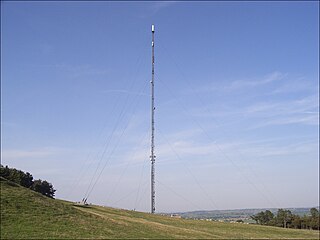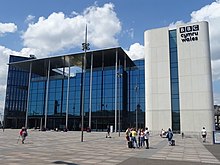
Channel 4 is a British free-to-air public broadcast television channel owned and operated by Channel Four Television Corporation. It is publicly owned but, unlike the BBC, it receives no public funding and is funded entirely by its commercial activities, including advertising. It began its transmission in 1982 and was established to provide a fourth television service in the United Kingdom. At the time, the only other channels were the licence-funded BBC1 and BBC2, and a single commercial broadcasting network, ITV.

S4C is a Welsh language free-to-air public broadcast television channel. Launched on 1 November 1982, it was the first television channel to be aimed specifically at a Welsh-speaking audience. S4C's headquarters are based in Carmarthen, at the University of Wales Trinity Saint David's creative and digital centre, Yr Egin. It also has regional offices in Caernarfon and Cardiff. As of 2024, S4C had an average of 118 employees. S4C is the fourth-oldest terrestrial television channel in Wales after BBC One, ITV and BBC Two.
Regular television broadcasts in the United Kingdom started in 1936 as a public service which was free of advertising, which followed the first demonstration of a transmitted moving image in 1926. Currently, the United Kingdom has a collection of free-to-air, free-to-view and subscription services over a variety of distribution media, through which there are over 480 channels for consumers as well as on-demand content. There are six main channel owners who are responsible for most material viewed.

BBC Cymru Wales is a division of the BBC and the main public broadcaster in Wales.

The Mendip transmitting station is a broadcasting and telecommunications facility on the summit of Pen Hill, part of the Mendip Hills range in Somerset, England, at 305 metres (1,001 ft) above sea level. The station is in St Cuthbert Out civil parish, approximately 2 miles (3.2 km) north-east of Wells. Its mast, 293 m (961 ft) high, was built in 1967 and is the tallest structure in South West England. The mast broadcasts digital television, FM analogue radio and DAB digital radio, and had broadcast analogue colour television from 1967 until 2010.
Digital terrestrial television in the United Kingdom encompasses over 100 television, radio and interactive services broadcast via the United Kingdom's terrestrial television network and receivable with a standard television set. The majority of digital terrestrial television (DTT) services, including the five former analogue channels, are broadcast free-to-air, and a further selection of encrypted pay TV services are also available.

The Moel-y-Parc transmitting station is situated on Moel y Parc, a hill in north-east Wales at the northern end of the Clwydian range, close to the town of Caerwys and several miles (kilometres) north-east of Denbigh. It was built in 1962/1963 by the IBA to bring 405-line VHF ITV television to North Wales and it has been on the air since 1963. Its original height of 229 metres (751 ft) made it the tallest structure in North Wales and it stands on land that is itself about 335 metres (1,099 ft) above sea level. In 1965, VHF television transmissions from the BBC commenced from the site.

The Wenvoe transmitting station, officially known as Arqiva Wenvoe, is the main facility for broadcasting and telecommunications for South Wales and the West Country. It is situated close to the village of Wenvoe in the Vale of Glamorgan, Wales, in the UK.
Analogue terrestrial television in the United Kingdom was originally the method by which the significant majority of viewers in the UK, the Channel Islands and the Isle of Man received television. Analogue terrestrial television broadcasts have fully ceased in the UK with Northern Ireland being the last region to have ceased transmission analogue terrestrial television broadcasts. Northern Ireland switched off the last analogue television signals, making all of the United Kingdom only capable of receiving digital television, in the early hours of 24 October, 2012. It has been completely replaced by digital terrestrial television and other non-terrestrial means as of the end of 2012.
High-definition television in the United Kingdom is available via cable, IPTV, satellite and terrestrial television. The first high-definition broadcasts began in late 2005 and since then the number of channels available to view has grown to a maximum of 87 that can be viewed on pay-TV service, Sky.

Radio broadcasting in Wales began in 1923 with the inauguration of the British Broadcasting Corporation's (BBC) station at Cardiff. Radio broadcasting has been a prime source of news and entertainment for the population of Wales since that date. As well as the public service provided by the BBC, Wales has private regional and national services producing programmes in both the Welsh and English languages; though the provision of Welsh language radio has been historically inconsistent and politically divisive.

ITV Wales and West, previously known as Harlech Television (HTV), was an ITV franchise area in the United Kingdom until 31 December 2013, licensed to a broadcaster by the regulator Ofcom.
In the 1960s and 1970s, an envisioned fourth UK television service was popularly referred to as ITV2, before the launch of Channel 4 in November 1982.

ITV Cymru Wales is the ITV franchise for Wales. The new separate licence began on 1 January 2014, replacing the long-serving dual franchise region ITV Wales & West serving Wales and the West of England, which had previously used the branding "ITV Wales" within the Wales subregion.
This is a timeline of the history of the British broadcaster Meridian Broadcasting. It has provided the ITV service for the South and South East of England since 1993.
This is a timeline of the history of ITV in Wales, including the current service ITV Cymru Wales. It does not include events that affect the whole UK network.
This is a timeline of the history of television in Wales. It does not include events that affect the whole UK.
This is a timeline of the history of S4C, originally the fourth-oldest terrestrial television channel in Wales. Until 2010 it carried a mixture of Welsh language programmes and programmes from Channel 4 which was not broadcast on analogue TV in Wales. In 2010, Channel 4 became available in Wales on all platforms and S4C became a Welsh-language-only channel.











